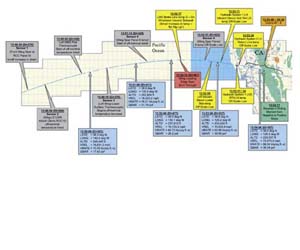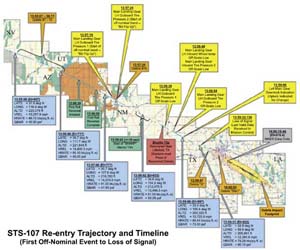2.6 DE-ORBIT BURN AND RE-ENTRY EVENTS
2.6 De-Orbit Burn and Re-Entry Events
― 軌道離脱噴射と再突入 ―
― 軌道離脱噴射と再突入 ―
At 2:30 a.m. EST on February 1, 2003, the Entry Flight Control Team began duty in the Mission Control Center. The Flight Control Team was not working any issues or problems related to the planned de-orbit and re-entry of Columbia. In particular, the team indicated no concerns about the debris impact to the left wing during ascent, and treated the re-entry like any other. The team worked through the de-orbit preparation checklist and re-entry checklist procedures. Weather forecasters, with the help of pilots in the Shuttle Training Aircraft, evaluated landing site weather conditions at the Kennedy Space Cen-ter. At the time of the de-orbit decision, about 20 minutes before the initiation of the de-orbit burn, all weather obser-vations and forecasts were within guidelines set by the flight rules, and all systems were normal.
東部標準時、2003年2月1日2:30AM、再突入フライトコントロールチームはミッションコントロールセンターで作業を始めました。彼らは、これから予定されているコロンビア号の軌道離脱や再突入に関連したいかなる懸念や問題も、顧みていませんでした。特に打上げの際の左翼への破片の衝突に対する配慮もなされず、通常通りの再突入として扱われました。チームは手順に従い、軌道離脱準備チェックリスト、再突入チェックリストを終了。天気予報官達は、シャトルのトレーニング用航空機のパイロットの助けを借りて、ケネディ宇宙センターの着陸地点の天候を評価しました。軌道離脱の判断がなされる軌道離脱噴射の20分前、全ての天候調査の結果と気象予報は飛行ルールで定められた基準の範囲内にあり、全てのシステムは正常に動作していました。
Shortly after 8:00 a.m., the Mission Control Center Entry Flight Director polled the Mission Control room for a GO/NO-GO decision for the de-orbit burn, and at 8:10 a.m., the Capsule Communicator notified the crew they were GO for de-orbit burn.
8:00AM、ミッションコントロールセンターのフライトディレクターは軌道離脱噴射の実行/中止(GO/NOGO)の判断を行うための投票をミッションコントロールルームで行いました。そして、8:10AMにカプセルコミュニケーターがシャトルの乗員に軌道離脱噴射を実行することを伝えました。
As the Orbiter flew upside down and tail-first over the Indian Ocean at an altitude of 175 statute miles, Commander Husband and Pilot McCool executed the de-orbit burn at 8:15:30 a.m. using Columbias two Orbital Maneuvering System engines. The de-orbit maneuver was performed on the 255th orbit, and the 2-minute, 38-second burn slowed the Orbiter from 17,500 mph to begin its re-entry into the atmosphere. During the de-orbit burn, the crew felt about 10 percent of the effects of gravity. There were no prob-lems during the burn, after which Husband maneuvered Columbia into a right-side-up, forward-facing position, with the Orbiters nose pitched up.
オービターは、インド洋上空175マイルを上下逆さに船尾を前に向けて飛行し、船長のハズバンドとパイロットのマックールが8:15:30AMにコロンビアの2基の姿勢制御システムを使って軌道離脱噴射(de-orbit burn)を実行しました。軌道離脱のための姿勢制御は軌道を225週したところで行われ、2分38秒の噴射でオービターは時速17,500マイル(28161km/h)から減速し、大気圏内に再突入を始めました。軌道離脱噴射が行われている間、飛行士達は地上の10%の加速度を感じていました。噴射は問題なく行われ、次にハズバンドはコロンビアを、機体の右側を上げ、機首を前に向け、さらに機首を上げた姿勢にしました。
Entry Interface, arbitrarily defined as the point at which the Orbiter enters the discernible atmosphere at 400,000 feet, occurred at 8:44:09 a.m. (Entry Interface plus 000 seconds, written EI+000) over the Pacific Ocean. As Columbia de-scended from space into the atmosphere, the heat produced by air molecules colliding with the Orbiter typically caused wing leading-edge temperatures to rise steadily, reaching an estimated 2,500 degrees Fahrenheit during the next six minutes. As superheated air molecules discharged light, astronauts on the flight deck saw bright flashes envelop the Orbiter, a normal phenomenon.
エントリーインターフェイス(再突入開始時間)は、オービターが高度400,000フィート(121.9km)で識別可能な大気圏に突入を開始する地点として恣意的に決められており、STS-107では太平洋上空で、8:44:09AMに始まりました(ここがエントリーインターフェイスプラス000秒、EI+000と表記します)。コロンビアが宇宙空間から、大気圏内へと高度を下げるに従って、機体特に主翼前縁部分に空気の分子が激しくぶつかり温度が上昇していきます。最終的には華氏2,500度(約摂氏1370度)に達し、その温度が6分間続きます。高温になった空気の分子は光を発し、通常、宇宙飛行士たちはデッキからオービターを包む明るいフラッシュのような光を見ることになります。
At 8:48:39 a.m. (EI+270), a sensor on the left wing leading edge spar showed strains higher than those seen on previous Columbia re-entries. This was recorded only on the Modular Auxiliary Data System, and was not telemetered to ground controllers or displayed to the crew (see Figure 2.6-1).
8:48:39AM(EI+270)、左翼の前縁部分の桁に設置されたセンサー系統がこれまでのコロンビアの飛行より高い数値を示しました。これは補助データシステムモジュールによって記録されたもので(事故後に回収されたもの)、地上のコントロールにも送信されず、コックピットにも表示されていませんでした(図2-6-1)。
At 8:49:32 a.m. (EI+323), traveling at approximately Mach 24.5, Columbia executed a roll to the right, beginning a pre-planned banking turn to manage lift, and therefore limit the Orbiters rate of descent and heating.
8:49:32AM(EI+323)、マッハ24.5(音速の24.5倍)で飛行しながら、コロンビアは右へとロールを開始しました。これは、あらかじめ定められた旋回で、揚力を調整してオービターの降下率と加熱速度が上がりすぎないようにするためのものです。
At 8:50:53 a.m. (EI+404), traveling at Mach 24.1 and at approximately 243,000 feet, Columbia entered a 10-minute period of peak heating, during which the thermal stresses were at their maximum. By 8:52:00 a.m. (EI+471), nearly eight minutes after entering the atmosphere and some 300 miles west of the California coastline, the wing leading-edge temperatures usually reached 2,650 degrees Fahrenheit. Columbia crossed the California coast west of Sacramento at 8:53:26 a.m. (EI+557). Traveling at Mach 23 and 231,600 feet, the Orbiters wing leading edge typically reached more than an estimated 2,800 degrees Fahrenheit.
8:50:53AM (EI+404)、マッハ24.1、高度約243,000フィート(74.1km)で、コロンビアは最も熱のストレスが大きく、最も温度が高くなる10分間に突入しました。カルフォルニアの海岸から300マイル(483km)西の地点、大気圏に突入してから約8分後、8:52:00 a.m. (EI+471)までに、通常、主翼の前縁部分の温度は華氏2,650度に達します。コロンビアはサクラメントの西方のカルフォルニアの海岸線を8:53:26AM (EI+557)に通過。この次点で、速度はマッハ23、高度が231,600フィート(70.6km)、主翼前縁部分の温度は推定で華氏2,800度(約摂氏1538度)を越えます。
Now crossing California, the Orbiter appeared to observ-ers on the ground as a bright spot of light moving rapidly across the sky. Signs of debris being shed were sighted at 8:53:46 a.m. (EI+577), when the superheated air surround-ing the Orbiter suddenly brightened, causing a noticeable streak in the Orbiters luminescent trail. Observers witnessed another four similar events during the following 23 seconds, and a bright flash just seconds after Columbia crossed from California into Nevada airspace at 8:54:25 a.m. (EI+614), when the Orbiter was traveling at Mach 22.5 and 227,400 feet. Witnesses observed another 18 similar events in the next four minutes as Columbia streaked over Utah, Arizona, New Mexico, and Texas.
カルフォルニア上空を通過。オービターは地上から見ている人には明るく輝く光点が空を速いスピードで横切っていくように見えました。破片の脱落の兆候は8:53:46AM (EI+577)に観測されました。オービターを包んでいた高温の大気が急に明るくなり、明るい光跡の中にはっきりと跡を残しました。目撃者は続く23秒間に4つの同じような現象を目にしています。さらに、8:54:25AM (EI+614)、コロンビアがカルフォルニア州からネバダ州へ入った直後に、明るい閃光が目撃されています。このときのオービターの速度はマッハ22.5、高度227,400フィート(69.3km)でした。続く4分間、コロンビアがユタ州・アリゾナ州・ニューメキシコ州・テキサス州を通過していく際、さらに18回、同じような現象が目撃されています。
In Mission Control, re-entry appeared normal until 8:54:24 a.m. (EI+613), when the Maintenance, Mechanical, and Crew Systems (MMACS) officer informed the Flight Director that four hydraulic sensors in the left wing were indicating "off-scale low," a reading that falls below the minimum capability of the sensor. As the seconds passed, the Entry Team contin-ued to discuss the four failed indicators.
ミッションコントロールでは、再突入は8:54:24AM (EI+613)までは異常は見られませんでした。この時、メンテナンス・メカニカル・乗務員関連システム主任(MMACS)はフライトディレクターに、左翼の4つの油圧センサーが「計測不能」になった― 計測値がセンサーの計測能力以下に下がった ―ことを報告しました。数秒間に渡って、大気圏突入チームはこの数値の低下について意見を交しました。
At 8:55:00 a.m. (EI+651), nearly 11 minutes after Columbia had re-entered the atmosphere, wing leading edge tempera-tures normally reached nearly 3,000 degrees Fahrenheit. At 8:55:32 a.m. (EI+683), Columbia crossed from Nevada into Utah while traveling at Mach 21.8 and 223,400 ft. Twenty seconds later, the Orbiter crossed from Utah into Arizona.
8:55:00AM (EI+651)、コロンビアが大気圏に突入してから11分後、この時点で主翼前縁部の温度は華氏3000度(約摂氏1639度)に達します。8:55:00AM(EI+683)、速度マッハ21.8、高度223,400フィート(68.1km)で、コロンビアはネバダ州からユタ州へ、さらに20秒後にはユタ州からアリゾナ州へ入りました。
At 8:56:30 a.m. (EI+741), Columbia initiated a roll reversal, turning from right to left over Arizona. Traveling at Mach 20.9 and 219,000 feet, Columbia crossed the Arizona-New Mexico state line at 8:56:45 (EI+756), and passed just north of Albuquerque at 8:57:24 (EI+795).
8:56:30AM(EI+741)には、コロンビアは右から左へと旋回するロールリバーサルを行いました(速度を落とすための旋回です)。マッハ20.9、高度219,000フィート(66.8km)で、コロンビアはアリゾナ州とニューメキシコ州の州境を8:56:45 (EI+756)に通過。アルバカーキの北を8:57:24 (EI+795)に通過しました。
Around 8:58:00 a.m. (EI+831), wing leading edge tem-peratures typically decreased to 2,880 degrees Fahrenheit. At 8:58:20 a.m. (EI+851), traveling at 209,800 feet and Mach 19.5, Columbia crossed from New Mexico into Texas, and about this time shed a Thermal Protection System tile, which was the most westerly piece of debris that has been recovered. Searchers found the tile in a field in Littlefield, Texas, just northwest of Lubbock. At 8:59:15 a.m. (EI+906), MMACS informed the Flight Director that pressure readings had been lost on both left main landing gear tires. The Flight Director then told the Capsule Communicator (CAPCOM) to let the crew know that Mission Control saw the messages and was evaluating the indications, and added that the Flight Control Team did not understand the crews last transmission.
8:58:00AM (EI+831)頃、主翼前縁の温度は華氏2,880度(約摂氏1582度)に下がります。8:58:20AM (EI+851)、速度マッハ19.5、高度209,800フィート(63.9km)でコロンビアはニューメキシコ州からテキサス州へと入りました。ちょうどこの時、最も西で発見された破片となった耐熱タイルが脱落しました。捜査員達はテキサス州のリトルフィールド、ラボックの北西で、このタイルを発見しました。8:59:15AM (EI+906)、MMCASはフライトディレクターに左の主着陸脚のタイヤの圧力が計測できなくなったことを報告しました。フライトディレクターは、カプセルコミュニケ―ター(CAPCOM)に、ミッションコントロールがこのタイヤ圧が計測できなくなったことを確認し、その評価していることを飛行士達に伝えるよう指示しました。そして、飛行士達の最後の通信が聞き取れなかったことを付け加えました。
At 8:59:32 a.m. (EI+923), a broken response from the mission commander was recorded: "Roger, [cut off in mid-word] ..." It was the last communication from the crew and the last telemetry signal received in Mission Control. Videos made by observers on the ground at 9:00:18 a.m. (EI+969) revealed that the Orbiter was disintegrating.
8:59:32AM (EI+923)、ミッションコマンダーからの途中で途切れた返答が記録されました「了解・・・(単語の途中で途切れる)」これが、乗務員からの最後の通信となり、ミッションコントロールが受け取った最後のテレメトリーになったのです。そして、9:00:18AM (EI+969)、地上で撮影されたビデオ映像が、オービターが空中分解したことを明らかにしました。
Figure 2.6-1. This simplified timeline shows the re-entry path of Columbia on February 1, 2003. The information presented here is a com-posite of sensor data telemetered to the ground combined with data from the Modular Auxiliary Data System recorder recovered after the accident. Note that the first off-nominal reading was a small increase in a strain gauge at the front wing spar behind RCC panel 9-left. The chart is color-coded: blue boxes contain position, attitude, and velocity information; orange boxes indicate when debris was shed from the Orbiter; green boxes are significant aerodynamic control events; gray boxes contain sensor information from the Modular Auxiliary Data System; and yellow boxes contain telemetered sensor information. The red boxes indicate other significant events.
図2-6-1(クリックで拡大):2003年2月1日のコロンビアの再突入時の軌道とイベントの抜粋。ここに書かれている情報は、地上でテレメトリされたセンサーのデータと、事故後に回収された補助データシステムモジュールの記録を合わせたものです。最初の異常な数値は、左9番RCCパネルのすぐ後ろ、主翼桁の前部分のひずみ計に僅かな上昇があったことでした。
このチャートは次のように色分けされています:青いボックスはオービターの位置・高度、速度の情報、オレンジのボックスはオービターからの破片の脱落、緑色のボックスは空力的なコントロール、灰色のボックスは補助データシステムモジュールのセンサーのデータ、黄色のボックスは地上でテレメトリされたセンサーの情報、赤いボックスはそれ以外の重要なイベントについてのものです。
このチャートは次のように色分けされています:青いボックスはオービターの位置・高度、速度の情報、オレンジのボックスはオービターからの破片の脱落、緑色のボックスは空力的なコントロール、灰色のボックスは補助データシステムモジュールのセンサーのデータ、黄色のボックスは地上でテレメトリされたセンサーの情報、赤いボックスはそれ以外の重要なイベントについてのものです。
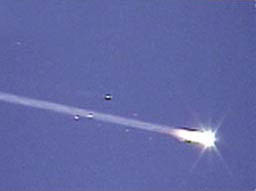
The Orbiter has a large glowing field surrounding it
in this view taken from Mesquite, Texas, looking south.
in this view taken from Mesquite, Texas, looking south.
オービターが大きく広がったフィールドに包まれている。
テキサス州メスキートから南向きに撮影されたもの。
テキサス州メスキートから南向きに撮影されたもの。
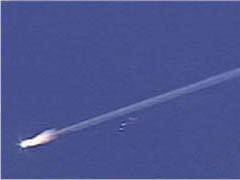
Taken at the same time as the photo at left, but from Hewitt, Texas, looking north.
同じ時間に、テキサス州ヒューイットから北向きに撮影された写真
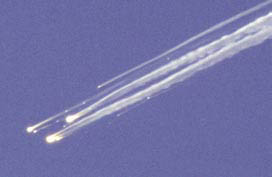
This view was taken from Dallas. (Robert McCullough/ 2003 The Dallas Morning News)
ダラスから撮影。 (Robert McCullough/ 2003 The Dallas Morning News)
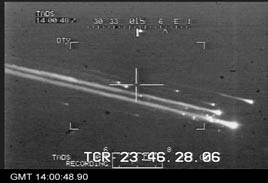
This video was captured by a Danish crew operating an AH-64 Apache helicopter near Fort Hood, Texas.
このビデオ映像は、テキサス州フォートフッド近郊で、
AH-64アパッチヘリコプターを操縦していたデンマーク人のクルーが撮影したもの
AH-64アパッチヘリコプターを操縦していたデンマーク人のクルーが撮影したもの
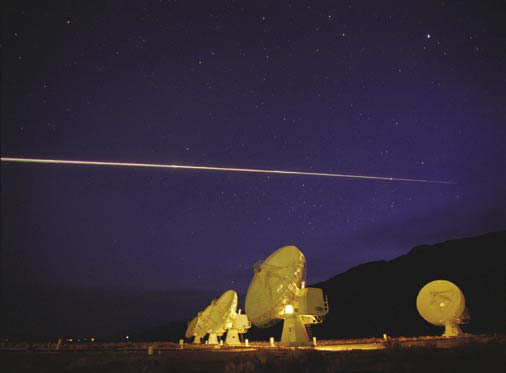
Columbia streaking over the Very Large Array radio telescope in Socorro, New Mexico.
コロンビアがニューメキシコ州ソコロの超大規模配列電波望遠鏡(VLA)の上を通過している。
MISSION CONTROL CENTER COMMUNICATIONS
